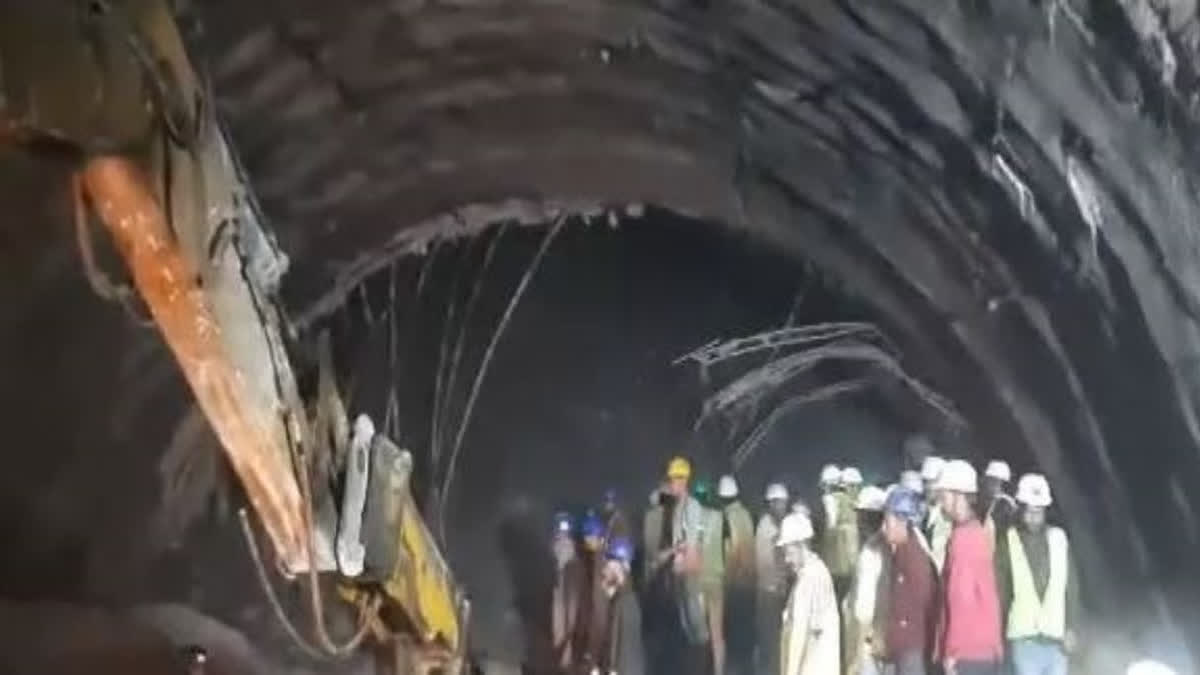New Delhi: The Uttarkashi tunnel collapse that has kept 41 workers trapped underground for over a week now might have occurred as the contractor did not adhere to safe and sustainable construction practices in a seismically sensitive region like the Himalayas, experts believe.
A portion of the under-construction Silkyara-Barkot tunnel collapsed early morning on November 12. The planned 4.5 km-long tunnel is part of the Char Dham all-weather road project and is located on the Yamunotri National Highway. The tunnel will reduce the distance to Yamunotri Dham by about 21 km and the travel time by one-and-a-half hours.
The construction of the tunnel was tendered to a Hyderabad-headquartered Company by the National Highways and Infrastructure Development Corporation Ltd (NHIDCL), a fully owned company of the Government of India.
There are two methods of tunnelling – the drilling and blasting method and the tunnel boring method. Navayuga is using the drilling and blasting method in the construction of the Silkyara-Barkot tunnel. Drilling and blasting is the controlled use of explosives and other methods, such as gas pressure blasting pyrotechnics, to break rock for excavation.
According to SP Sati, a leading geologist who heads the Basic and Social Science department at the College of Forestry in the Veer Chandra Singh Garhwali Uttarakhand University of Horticulture and Forestry, drilling and blasting for construction of underground tunnels in a seismically sensitive zone like the Himalayas is not prescribed.
“They don’t have tunnel boring machines,” Sati told ETV Bharat. “That is why they are going for dynamite blasting. Strong safety protocols should be prescribed which they have not done I think.”
According to Koushik Pandit, Senior Scientist at the Roorkee-based CSIR-Central Building Research Institute who visited the site of the incident, the collapse occurred around 200 m from the Silkyara portal or entry point of the tunnel.
Pandit, who is a member of the expert technical committee set up by the Uttarakhand State Disaster Management Authority to probe the incident, told ETV Bharat that the roof collapse might have occurred due to various reasons. One of them might be due to a faster rate of construction of the tunnel.
“They seem to have used explosives more than the prescribed limits,” he said. “This might have weakened the rock mass surrounding the tunnel axis and during re-profiling work, might have exposed a weak shear zone that led to a rock fall.”
A shear zone is a thin zone within the earth’s crust or upper mantle that has been strongly deformed, due to the walls of rock on either side of the zone slipping past each other. In the upper crust, where rock is brittle, the shear zone takes the form of a fracture called a fault.
Pandit said that the target for completion of the tunnel was set for May 2024. But now it will be delayed due to the ongoing situation there. Construction had begun in 2018.
“Eight months before too a similar incident happened,” he said. “Rock fall happened multiple times but not at such a huge scale.” Experts believe that there were engineering lapses that could have led to the tunnel roof collapse. Pandit explained that there are two popular types of tunnelling methods – the Norwegian Tunneling Method (NTM) and the New Austrian Tunneling Method (NATM). Here, NATM is being used.
“After drilling a hole, you put in dynamite and blast it,” he said. “Then you leave the blasted area free standing for six to 24 hours. After that, primary support is installed. Steel lattice girder or steel rib, rock bolts and sprayed shotcrete (a mixture of aggregate and portland cement, conveyed by compressed air to the nozzle of a spray gun, where water is added) are used for this. Then, within four to six months, a final support (a cast-in-place concrete lining) is installed over a waterproofing membrane. Once final support is there, you cannot change anything.”
According to sources, at the collapse site, the primary support was installed in 2019. The contractor did not install the final support within four to six months as required. The primary support was left standing for four years now. The contractor apparently was more interested in completing the tunnel, primary observations indicate. So, the firm continued excavating at a fast pace to show progress and completion of the tunnel. In most of the parts of the tunnel, there was no final support, however, primary supports were installed.
“The second reason is that the Himalaya is a very fragile region and you get geological surprises,” Pandit said. “The geologist consultant of the contractor must have missed out on a shear zone. They must have hit a shear zone because of which very weak rocks in crushed form fell down.”
Meanwhile, rescue efforts to pull the workers out met with a hurdle on Friday. The idea is to insert a pipe of 80 cm in diameter and pull the workers out through it. However, the auger machine being used to drill a hole for inserting the pipe from the Silkyara portal hit a block.
According to Pandit, nobody is sure what the block is. It might be a large rock boulder or machinery being used inside. A team from Delhi has reached the site and is using ground penetration radar (GPR), seismic refraction, and electrical resistivity tomography (ERT) to find out what is inside. Once it is found, the pipe will have to be realigned.
Meanwhile, efforts are now also on to insert a pipe vertically to reach the workers. For that also, geophysical scanning of the top surface was explored.
Read More
- What could have prevented the Uttarkashi tunnel collapse? This geologist has an answer
- Uttarakhand tunnel collapse: Docs worried about possible panic attacks due to prolonged confinement in enclosed space
- Uttarakhand tunnel collapse: Indian Army called in to build 320 metre track near tunnel to save trapped workers



